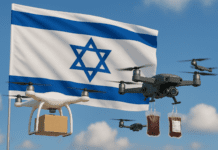This post is also available in:
 עברית (Hebrew)
עברית (Hebrew)
Robots help secure remote facilities and wide-area perimeters. Security robotics is a relatively new field, but it’s already shown impressive innovation featuring new technologies. Roboticstomorrow.com elaborates on recent developments that show potential in security robotics:
- Real-Time Video Analytics – While early security robots either sent live video feeds to remote operators or recorded video data for future use, advances in machine learning let robots recognize objects and movements in real-time, letting them react independently to their situation. Capabilities include the recognition and scanning of license plates in order to detect suspects’ vehicles or stolen cars, for example.
- Unique Media Access Control (MAC) Address Recognition – New tools let security robots scan local networks to check devices’ MAC addresses, which are unique digital signatures that identify phones and computers.
- Power Source – Standard Lithium-ion batteries have limited operation times, especially in robots and drones, due to their small size. Graphene batteries can help security robots operate for far longer between charges, making them more useful. These batteries can retain 80% of their capacity through 1,400 charging cycles, charge faster than traditional alternatives, last longer, and operate at extreme temperatures.
- Hyper-Spectral Cameras – Machine vision is at the heart of many security robots. But it can only be as effective as the cameras that provide data. Hyper-spectral (HS) cameras can collect the full-color spectrum of a scene, making it easier for machine vision to work.
- Sound Recognition – Machine learning-powered sound recognition works like machine vision but helps robots detect and recognize audio signals like gunshots, breaking glass, alarms, or screams. New sound recognition algorithms use a library of more than six million audio files, with similar sounds clustered into groups. This organization enables robots to register what type of sound they’ve heard, then narrow it down to possible sources. They can then provide a more accurate alert to security personnel and other people in the area.


























